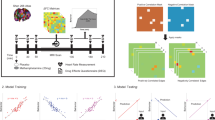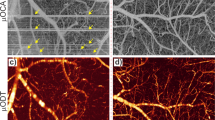Abstract
Opiate replacement therapy has been useful in reducing heroin use and in keeping patients in treatment programs. However, neuropsychological and neurophysiological effects of this treatment regimen have not been evaluated systematically. To determine whether methadone treatment reduces the magnitude of cerebral blood flow alternations in polysubstance (heroin and cocaine) abusers, we compared blood flow parameters in control subjects (n=26), polysubstance abusers (n=28) maintained on methadone for 24 weeks, and polysubstance abusers (n=22) who were not seeking treatment. Blood flow velocity was recorded from the anterior and middle cerebral arteries using transcranial Doppler sonography on an outpatient visit. The pulsatility index, a measure of cerebrovascular resistance, was significantly (p<0.05) increased in both groups of polysubstance abusers compared to control subjects. Increased pulsatility in the two groups of substance abusers suggests constriction of the small cortical arteries. Nevertheless, the methadone-maintained polysubstance abusers had significantly lower pulsatility values than the nontreatment substance-abusing group. These findings suggest that maintenance on methadone might have significant beneficial neurovascular effects on this population of patients.
Similar content being viewed by others
Log in or create a free account to read this content
Gain free access to this article, as well as selected content from this journal and more on nature.com
or
References
Anstey KJ, Smith GA (1999). Interrelationships among biological markers of aging, health, activity, acculturation, and cognitive performance in late adulthood. Psychol Aging 14: 605–618.
Arjona A, Prula LA (2002). Mean velocity and pulsatility index in primary headaches. Rev Neurol 34: 414–316.
Arnolds BJ, von Reutern GM (1986). Transcranial Doppler sonography: examination technique and normal reference values. Ultrasound Med Biol 12: 115–123.
Ben Dians MK, Feroni I, Ponet M, Obadia Y (2000). Chief health risks associated with intravenous heroin and cocaine abuse. Presse Med 29: 453–457.
Biedert S, Hwer W, Forst H (1995). Multiinfarct dementia vs Alzheimer's disease: sonographic criteria. Angiology 46: 129–135.
Cho S, Kim GW, Sohn YH (1997). Blood flow velocity changes in the middle cerebral artery as an index of chronicity of hypertension. J Neurol Sci 50: 77–80.
Community Epidemiology Work Group (2001). Epidemiologic trends in drug abuse. Proceedings of the Community Epidemiology Work Group; Bethesda. NIH publication No. 01-4916A.
Cruickshank JM, Neil-Dwyer G, Dorrance DE, Haynes Y, Patel S (1989). Acute effects of smoking on blood pressure and cerebral blood flow. J Hum Hypertens 3: 443–339.
Czosnyka M, Pickard J, Whitehouse HE, Richards HK (1996). Relationship between transcranial Doppler-determined pulsatility index and cerebrovascular resistance: an experimental study. J Neurosurg 84: 79–84.
Danos P, Kasper S, Grunwald F, Klemm E, Krappel C, Broich K et al (1998). Pathological regional cerebral blow flow in opiate-dependent patients during withdrawal: a HMPAO-SPECT study. Neuropsychobiology 37: 194–199.
Grubb BP, Hahn H, Elliott L, Brewster P, Wolfe D, Kosinski D et al (1998). Cerebral syncope: loss of conscious associated with cerebral vasoconstriction in the absence of systemic hypotension. Pacing Clin Electrophysiol 21: 652–658.
Herning RI, Better W, Tate KY, Cadet JL (2001). Marijuana abusers are at increased risk for stroke: preliminary evidence from cerebrovascular perfusion data. In: Slikker W, Trembly B (eds). Neuroprotective Agents: Fifth International Conference. Ann NY Acad Sci 939: 411–415.
Herning RI, King DE, Better WE, Cadet JL (1999). Neurovascular deficits in cocaine abusers. Neuropsychopharmacology 21: 110–118.
Herning RI, Tate KY, Better W, Cadet JL (2002). Cerebral blood flow pulsatility deficits in HIV+cocaine abusers: differences associated with antiviral medications. Drug Alcohol Depend 65: 129–135.
Holman BL, Carvalho PA, Mendelson J, Teoh SK, Nardin R, Hallgring JK et al (1991). Brain perfusion is abnormal in cocaine-dependent polydrug users: a study using technetium-99m-NMPAO and ASPECT. J Nucl Med 32: 1206–1210.
Howard G, Baker WH, Chambless LE, Howard VJ, Jones AM, Toole JT (1996). An approach for the use of Doppler ultrasound as a screening tool for hemodynamically significant stenosis. Stroke 27: 1951–1957.
Hser YI, Hoffman V, Grella CF, Anglin MD (2001). A 33-year follow-up of narcotic addicts. Arch Gen Psychiatry 58: 503–508.
Jamrozik K, Broadhurst RJ, Forbes S, Hankey GJ, Anderson CS (2000). Predictors of death and vascular events in the elderly: the Perth Community Stroke Study. Stroke 31: 863–868.
Johnson RE, Chutuape MA, Strain EC, Walsh SJ, Stitzer WL, Bigelow GE (2000). A comparison of levomethadyl acetate, buprenorphine,and methadone for opioid dependence. N Engl J Med 343: 1290–1297.
Jones HE, Herning RI, Cadet JL, Griffiths RR (2000). Caffeine withdrawal increases blood flow velocity and alters quantitative electroencephalographic activity. Psychopharmacology 147: 371–377.
Kidwell CS, El-Saden D, Livhits Z, Martin NA, Glenn TC, Saver JL (2001). Trancranial Doppler pulsatility indices as a measure of diffuse small-vessel disease. J Neuroimaging 11: 229–235.
Kodaira K, Fujishiro K, Wada T, Satoi T, Tsukiyana E, Fukumoto T et al (1993). A study on cerebral nicotine receptor distribution, blood flow, oxygen consumption and other metabolic activities—a study on the effects of smoking on carotid and cerebral artery blood flow. Yakubutsu Seishin Kodo 13: 157–165.
Lee KY, Sohn YH, Baik JS, Kim GW, Kim S-J (2000). Arterial pulsatility as an index of cerebral microangiopathy in diabetes. Stroke 31: 1111–1115.
Levin JM, Holman BL, Mendelson TH, Teoh SK, Garanda B, Johnson KA et al (1994). Gender differences in cerebral perfusion in cocaine abuse: technetium-99m-HMPAO SPECT study of drug using women. J Nucl Med 35: 1902–1909.
Levin JM, Mendelson JH, Holman BL, Teoh SK, Garada B, Schwartz RB et al (1995). Improved regional cerebral blood flow in chronic cocaine polydrug users treated with buprenorphine. J Nucl Med 35: 1902–1904.
Martin PJ, Evans DH, Naylor AR (1994). Transcranial color-coded sonography of basal cerebral circulation: reference data from 115 volunteers. Stroke 25: 390–396.
McLellan AT, Luborsky L, Cacciola J, Griffith J, McGaham P, O'Brien CP (1986). Guide to the Addiction Severity Index: Background, Administration, and Field Testing Results. National Institute on Drug Abuse, Treatment Research Reports: Rockville, MD.
Monitoring the Future Study, National Results on Adolescent Drug Abuse: Overview of Key Findings (2000). NIDA 3, 37 pp, BKD361.
Morioka C, Konodo H, Akashi K, Matsumura K, Ochi N, Makinaga G et al (1997). The continuous and simultaneous blood flow velocity measurement of four cerebral vessels and a peripheral vessel during cigarette smoking. Psychopharmacology 131: 220–229.
O'Connor PG, Fiellin DA (2000). Pharmacologic treatment of heroin-dependent patients. Ann Intern Med 133: 40–54.
Preston KL, Umbricht A, Epstein DH (2000). Methadone dose increase and abstinence reinforcement for treatment of continued heroin use during methadone maintenance. Arch Gen Psychiatry 57: 395–404.
Rabbitt P, Lowe C (2000). Patterns of cognitive ageing. Psychol Res 63: 308–316.
Robins S, Helzer JE, Cuttler L, Golding E (1988). National Institute of Mental Health Diagnostic Interview Schedule Version III-R.
Rose JS, Branchey M, Buydens-Branchey L, Stapleton JM, Chasten K, Werrell A et al (1996). Cerebral perfusion in early and late opiate withdrawal: a technetium-99m-HMPO SPECT study. Psychiatry Res: Neuroimaging 67: 39–47.
Sattel H, Biedert, Forstl H (1996). Senile dementia of Alzheimer type and multi-infarct dementia investigated by transcranial Doppler. Dementia 7: 41–46.
Silvestrini M, Troisi E, Matteis M, Cupini LM, Caltagirone C (1996). Transcranial Doppler assessment of cerebrovascular reactivity in symptomatic and asymptomatic severe carotid stenosis. Stroke 27: 1970–1973.
Strandgaard S (1993). The cerebral circulation in the elderly: the influence of age, vascular disease, and antihypertensive treatment. Am J Geriatr Cardiol 2: 32–36.
Steinmeier R, Laumer R, Bondar I, Priem R, Fahlbush R (1993). Cerebral hemodynamics in subarachnoid hemorrhage evaluated by transcranial Doppler sonography. Part 2. Pulsatility index: normal reference values and characteristics in subarachoid hemorrhage. Neurosurgery 31: 10–19.
Tumeh SS, Nagel JS, English RJ, Moore M, Holman BL (1990). Cerebral abnormalities in cocaine abusers: demonstration by SPECT perfusion brain scintigraphy. Radiology 176: 821–824.
van Dyck CH, Rosen MI, Thomas M, McMahon TJ, Wallace EA, O'Connor PG et al (1994). SPECT regional cerebral blood flow alteration in naltrexone-precipital withdrawal from buprenorphine. Psychiatry Res: Neuroimaging 55: 181–191.
Volkow ND, Fowler JS, Wolf AP, Hitzemann R, Dewey S, Hoff A (1991). Changes in brain glucose metabolism in cocaine dependence and withdrawal. Am J Psychiatry 148: 621–626.
Weber DA, Klieger P, Volkow ND, Sacher D, Ivanovic M (1990). SPECT regional cerebral blood flow (rCBF) studies in crack users and control subjects. J Nucl Med 31: 876–877.
Author information
Authors and Affiliations
Corresponding author
Rights and permissions
About this article
Cite this article
Herning, R., Better, W., Tate, K. et al. Methadone Treatment Induces Attenuation of Cerebrovascular Deficits Associated with the Prolonged Abuse of Cocaine and Heroin. Neuropsychopharmacol 28, 562–568 (2003). https://doi.org/10.1038/sj.npp.1300073
Received:
Revised:
Accepted:
Published:
Issue date:
DOI: https://doi.org/10.1038/sj.npp.1300073
Keywords
This article is cited by
-
Impaired working memory performance in opioid-dependent patients is related to reduced insula gray matter volume: a voxel-based morphometric study
European Archives of Psychiatry and Clinical Neuroscience (2021)
-
Aktuelle Konsumformen bei Drogenabhängigkeit — Implikationen für Substitutionsprogramme in ambulanten Einrichtungen und bei behandelnden Ärzten
Wiener Klinische Wochenschrift (2004)



